Paper Menu >>
Journal Menu >>
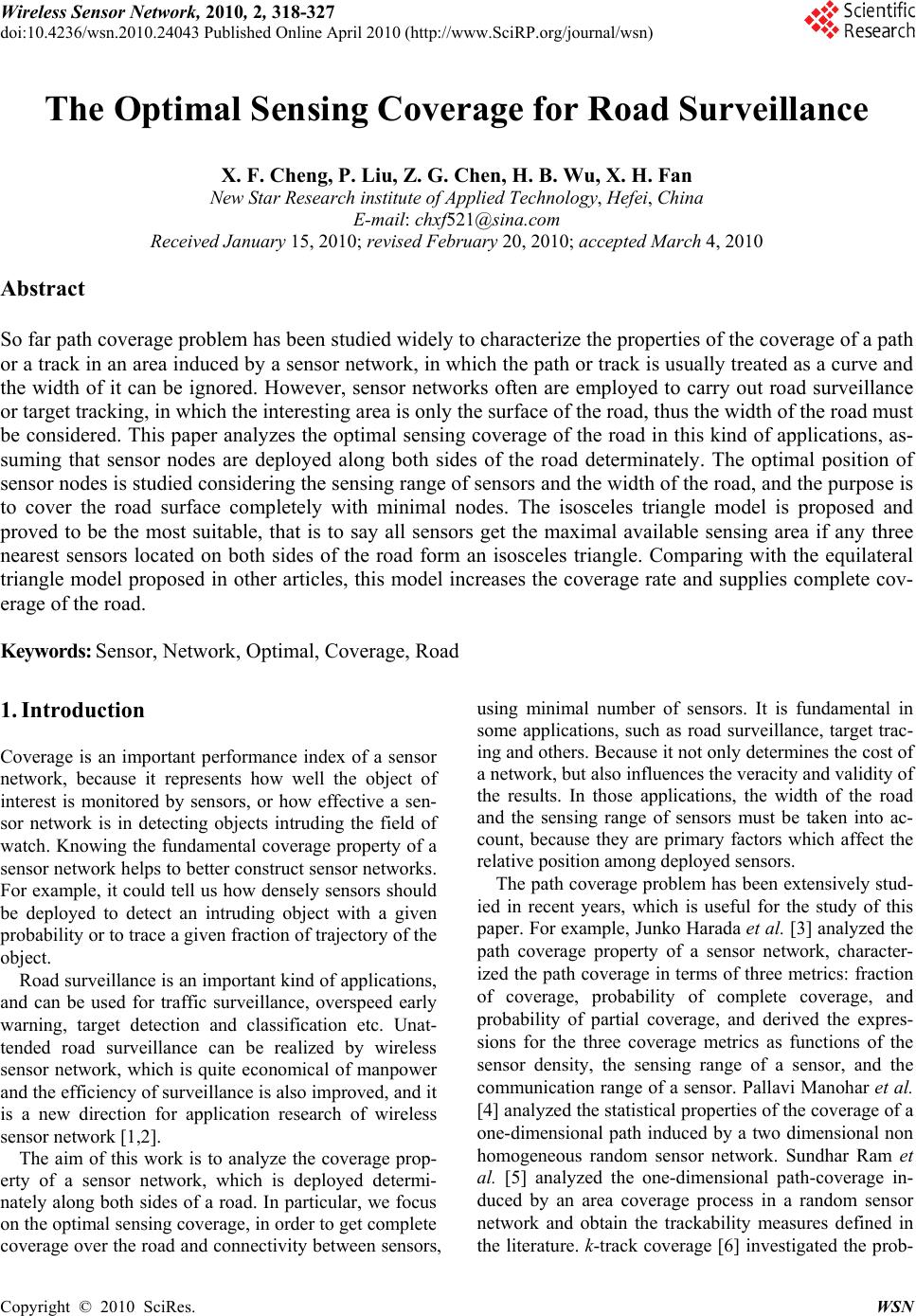 Wireless Sensor Network, 2010, 2, 318-327 doi:10.4236/wsn.2010.24043 Published Online April 2010 (http://www.SciRP.org/journal/wsn) Copyright © 2010 SciRes. WSN The Optimal Sensing Coverage for Road Surveillance X. F. Cheng, P. Liu, Z. G. Chen, H. B. Wu, X. H. Fan New Star Research institute of Applied Technology, Hefei, China E-mail: chxf521@sina.com Received January 15, 2010; revised February 20, 2010; accepted March 4, 2010 Abstract So far path coverage problem has been studied widely to characterize the properties of the coverage of a path or a track in an area induced by a sensor network, in which the path or track is usually treated as a curve and the width of it can be ignored. However, sensor networks often are employed to carry out road surveillance or target tracking, in which the interesting area is only the surface of the road, thus the width of the road must be considered. This paper analyzes the optimal sensing coverage of the road in this kind of applications, as- suming that sensor nodes are deployed along both sides of the road determinately. The optimal position of sensor nodes is studied considering the sensing range of sensors and the width of the road, and the purpose is to cover the road surface completely with minimal nodes. The isosceles triangle model is proposed and proved to be the most suitable, that is to say all sensors get the maximal available sensing area if any three nearest sensors located on both sides of the road form an isosceles triangle. Comparing with the equilateral triangle model proposed in other articles, this model increases the coverage rate and supplies complete cov- erage of the road. Keywords: Sensor, Network, Optimal, Coverage, Road 1. Introduction Coverage is an important performance index of a sensor network, because it represents how well the object of interest is monitored by sensors, or how effective a sen- sor network is in detecting objects intruding the field of watch. Knowing the fundamental coverage property of a sensor network helps to better construct sensor networks. For example, it could tell us how densely sensors should be deployed to detect an intruding object with a given probability or to trace a given fraction of trajectory of the object. Road surveillance is an important kind of applications, and can be used for traffic surveillance, overspeed early warning, target detection and classification etc. Unat- tended road surveillance can be realized by wireless sensor network, which is quite economical of manpower and the efficiency of surveillance is also improved, and it is a new direction for application research of wireless sensor network [1,2]. The aim of this work is to analyze the coverage prop- erty of a sensor network, which is deployed determi- nately along both sides of a road. In particular, we focus on the optimal sensing coverage, in order to get complete coverage over the road and connectivity between sensors, using minimal number of sensors. It is fundamental in some applications, such as road surveillance, target trac- ing and others. Because it not only determines the cost of a network, but also influences the veracity and validity of the results. In those applications, the width of the road and the sensing range of sensors must be taken into ac- count, because they are primary factors which affect the relative position among deployed sensors. The path coverage problem has been extensively stud- ied in recent years, which is useful for the study of this paper. For example, Junko Harada et al. [3] analyzed the path coverage property of a sensor network, character- ized the path coverage in terms of three metrics: fraction of coverage, probability of complete coverage, and probability of partial coverage, and derived the expres- sions for the three coverage metrics as functions of the sensor density, the sensing range of a sensor, and the communication range of a sensor. Pallavi Manohar et al. [4] analyzed the statistical properties of the coverage of a one-dimensional path induced by a two dimensional non homogeneous random sensor network. Sundhar Ram et al. [5] analyzed the one-dimensional path-coverage in- duced by an area coverage process in a random sensor network and obtain the trackability measures defined in the literature. k-track coverage [6] investigated the prob-  X. F. CHENG ET AL.319 lem of finding the configuration of a network with n sensors so that the number of tracks intercepted by k sensors is optimized without providing redundant area coverage over the entire region. These studies considered the coverage property of a path or a track in an area in- duced by a sensor network. Expressions or formulas de- rived in these papers are not suitable for the problem proposed in this paper. Kurlin et al. [7] proposed a method to find the mini- mal number of sensors randomly deployed along a one-dimensional path to make a network connected with a given probability. The paper also described a powerful method for explicitly computing the probability of con- nectivity of 1-dimensional networks. However, the path coverage probability is not taken into account, which is vital in road surveillance applications. The optimal configuration of sensor nodes has also been focused on, such as the equilateral triangle model [8], which means that if the region R is large enough as compared to the sensing range of each sensor node, to cover region R completely with minimal number of nodes, sensor nodes should be placed as follow: any three disks composed by the coverage area of a sensor node centered at itself should intersect at one point and form an equilateral triangle with side length3 s r, where is the sensing range of sensors, see Figure 1. Since sensor nodes can but be placed along both sides of the road in the kind of road surveillance application, they form an equilateral triangle if and only if the width of the road d objects to (1). However, the width of the road may vary from a couple of meters to dozens of meters, and the sensing range of sensors is also variable in practice, and both of them can not object to (1) in most times. s r 3 3sin 32 s s dr r (1) The contribution of this work is to analyze the optimal sensing coverage for road surveillance taking account of the sensing range of sensors and the width of the road. As a result, we find that the maximal available sensing area of the networked sensors can be achieved when the positions of every three closest sensors form an isosceles triangle. The rest of this article is organized as follows. In Section 2, s r s r3 Figure 1. The equilateral triangle model. we present some related background on the road cover- age. In Section 3, we analyze the optimal sensing cover- age, present and prove our propositions while the sensing d d subject to range of sensorssand the width of the roa /2 s drd r and s rd respectively. In Section 4, we the conclusion of this paper. . Background of Road Coverage Ro compare our isosceles model with the equilateral model. Some simulation experiments about the number of sensor nodes required to cover a road optimally have been done based on our research results in Section 5. The Section 6 is 2 ad surveillance and target tracking are common appli- cations of Wireless Sensor Network. The coverage prob- ability varies from different purpose, and we assume that we need to cover the road surface completely in this paper. 2.1. Sensing Model We assume that each sensor has the same sensing range, s r. A sensor can detect all events within isensin range with probability 1, but it cannot detect any events at all outside the sensing range. This simplified sensing model is usually called “Boolean sensing model” [9,10]. We also assume that each sensor has an identical communication range, rw. A sensor can communicate with all sensors within its communication range. Zhang et al. [8] proved that the conditi ts g on of ≥ 2 ensure that complete overage of a convex region implies connectivity in an and the road surface in practice. Thus they are usually placed along both sides of e sens the road. 2.3. Relaad and Sensing Range of Sensors d and sensing range of sensors w r s r is both necessary and sufficient to c arbitrary network, assuming the monitored region is a convex set. For clarity of discussion, we assume that communication range is at least twice of sensing range in this paper, and then the set of sensor nodes is connective if it covers the road surface completely. 2.2. Structure of the Network The sensor nodes may be found or damaged by trucks people if they are deployed on the road, even keep away from the road sides. Figure 2 shows the structure of the network. We can see that all snsor nodes form two parallel lines. We assume that all ors are deployed along both sides of tionship between Width of the Ro In this article, we denote the width of the road as d. Then the relationship between s r may be as follow: Copyright © 2010 SciRes. WSN 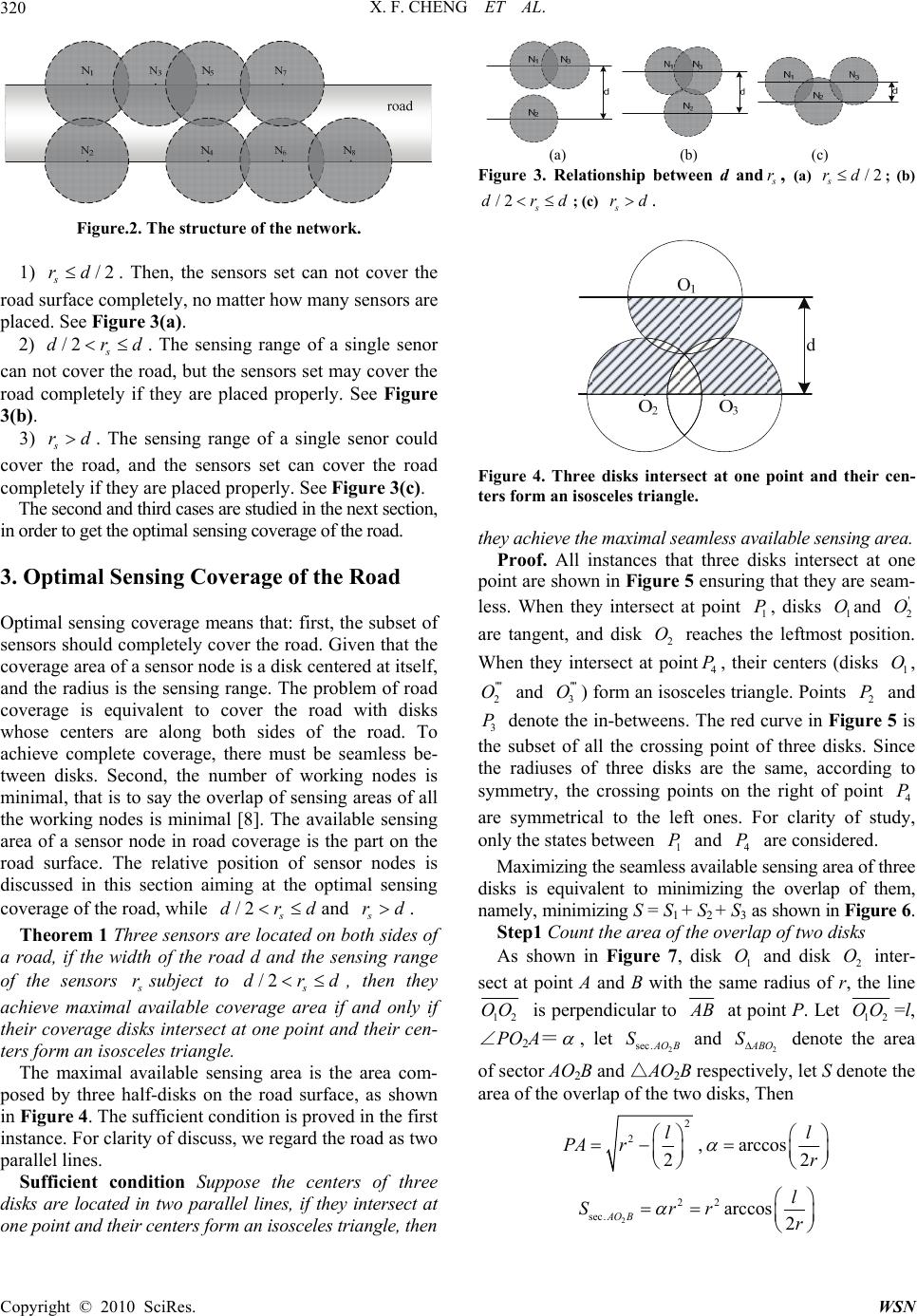 X. F. CHENG ET AL. 320 Figure.2. The structure of the network. 1) /2 s rd. Then, the sensors set can not cover t oad surface completely, no matter how many sensors he are eans that: firset of se hge. The prob tw The relative position of sensor nodes is a road, if the width of the road d and the sensing range of the sensors r placed. See Figure 3(a). 2) /2 s drd. The sensing range of a single senor can not cover the road, but the sensors set may cover the road completely if they are placed properly. See Figure 3(b). 3) s rd. The sensing range of a single senor could cover the road, and the sensors set can cover the road completely if they are placed properly. See Figure 3(c). The second and third cases are studied in the next section, in order to get the optimal sensing coverage of the road. 3. Optimal Sensing Coverage of the Road Optimal sensing coverage mst, the sub nsors should completely cover the road. Given that the coverage area of a sensor node is a disk centered at itself, and the radius is te sensing ranlem of road coverage is equivalent to cover the road with disks whose centers are along both sides of the road. To achieve complete coverage, there must be seamless be- een disks. Second, the number of working nodes is minimal, that is to say the overlap of sensing areas of all the working nodes is minimal [8]. The available sensing area of a sensor node in road coverage is the part on the road surface. discussed in this section aiming at the optimal sensing coverage of the road, while /2 s drdand s rd. Theorem 1 Three sensors are located on both sides of s rsubject to d, then they achieve maximal available coverage area if and only if their coverage disks intersect at one point and their cen- ae area c posed by thalf-dion the road surface, as shown Figure 4. sufficient condition is proved in the first stance. For clarity of discuss, we regard the road as two parallel lines. Sufficient condition Suppose the centers of three disks are located in two parallel lines, if they intersect at one point and their centers form an isosceles triangle, then /2 s dr ters form an isosceles triangle. The maximal available sensing are is thom- ree hsks The in in (a) (b) (c) Figure 3. Relationship between d and s r, (a) /2 s rd ; (b) d/2 s dr ; (c) s rd. Figure 4. Three disks intersect at one point and their cen- form asosceles triangle. they achieve the maximal seamless available sensing area. Proof. All instances that three disks intersect at one point are shown in Figure 5 ensuring that they are seam- less. When they intersect at point 1 P, disks 1 Oand 2 O are tangent, and disk Oreaches the leftmost position. ters n i W st ee 1 2 3 in Figure 6. Step1 Count the area of the overlap of two disks As shown in Figure 7, disk and disk inter- sect at point A and B with th radius of e line ' u 2 n 1 P hen they intersect at point4 P, their centers (disks 1 O, '''' 2 O and '''' 3 O) form an isosceles triangle. Points 2 P and PFigure 5 is 3 the su are denote the in-betweens. The red curve in int ksbset of all the crossing poof three dis. Since the radiuses of three disks are the same, according to symmetry, the crossing points on the right of point 4 P ymmetrical to the lefes. For clarity ody, only the stas betw and e considered. Maximizing the seamless available sensing area of three disks is equivalent to minimizing the overlap of them, namely, minimizing S = S+ S+ S as shown onf st te 4 arP 1 O e same 2 O r, th 12 OO int P. Let 12 OOis perpendicular to A B at po=l, ∠PO2A= , let and denote the area of sector AO2B and △AO2B respectively, let S denote the area of the overlap of the two disks, Then 2 sec.AOB S2 O AB S 2 2 2 l PAr ,arccos 2 l r 2 22 sec. arccos 2 AO B l Srrr Copyright © 2010 SciRes. WSN 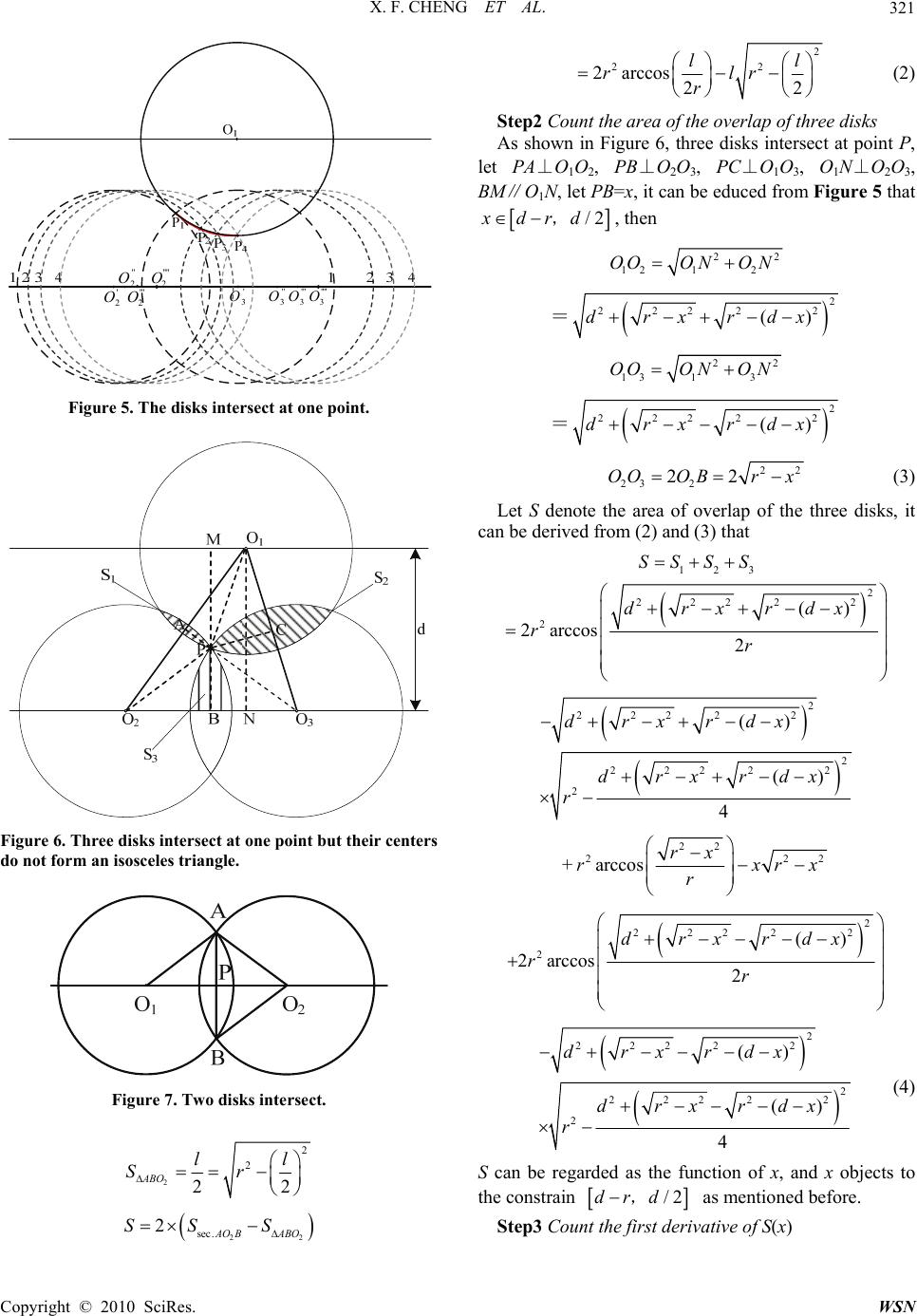 X. F. CHENG ET AL.321 ' 2 O '' 2 O '''' 2 O ''' 2 O ' 3 O '' 3 O'''' 3 O ''' 3 O Figure 5. The disks intersect at one point. Figure 6. Three disks intersect at one point but their centers do not form an isosceles triangle. Figure 7. Two disks intersect. 222 2AO SS S 2 2 ABO ll Sr 22 sec. B ABO 2 22 arccos ll 222 rlr r (2) Step2 Count the area of the overlap of three disks As shown in Figure 6, three disks intersect at point P, let PA⊥O2, PB⊥O2O3, PC⊥O1O3, O1⊥O2O3, BM∥O NPB=x, it can be educed from Figure 5 that O1N , let 1 /2xdrd ,, then 22 12 12 OOONO N 2 2222 2 ()drxrdx = 22 13 13 OOONON 2 2222 2 ()drxrdx = 22 23 2 22OOOBrx (3) Let S denote the area of overlap of the three disks, it can be derived from (2) and (3) that 312 SSS S 2 2222 2 2 () 2 arccos2 drxrdx rr 2 2222 2 2 2222 2 2 () () 4 drxrdx drxrdx r + 22 22 arccos rx rx r 2 rx 2 2222 2 2 () 2 arccos2 drxrdx rr 2 2222 2 ()d rdx 2 rx (4) S can be regarded as the function the constrain 22 22 2 2 () 4 dr xrdx r of x, and x objects to /2drd, as mentioned before. Step3 Count the first derivative of S(x) Copyright © 2010 SciRes. WSN  X. F. CHENG ET AL. 322 We count the first ative of (4)nd simplify th expressi deriv ae on, and then the result is 22 2 '( ) x dx rx Sx , (5) /2drxd 0dx , '( )0Sx, ()is a monotonic constrain of Sx inicreasing functon subject to the /2dr,d, and ()Sx gets minimum at x dr, in this instance, we can derive from (3) that 2 2222 2 12 2 2 ()OOdrxrd x OO d (6) 222 2 a d make it intersect us, t y must inters one pmal. Ste the maamle availe sen is 13 () rxrdx It is clear that △OO2Ois an 13 isosceles triangle ac- cording to (6). And then we can summarize that disks O1, O2 and O3 get the maximal seamless available sensing area at this time. The sufficient condition has been confirmed, and then the necessary condition is proved. Necessary condition Suppose the centers of three disks are located in two parallel lines, if they achieve the maximal seamless available sensing area, then they must intersect at one point and their centers form an isosceles triangle. Proof. First, we prove that they must intersect at one point, and then their centers formn isosceles triangle. Step 1 Reduction to absurdity is adopted. Assume that three disks do not intersect at one point and the overlap of them is minimal, then there must exist an area belongs to all of them to ensure seamless, see Figure 8(a). Con- sider, for example, move disk 3 O an disks A and B at one point as shown in Figure 8(b). It is clear that S1 makes no difference, but both S2 and S3 become smaller, so S is smaller than before. Thhe primary assumption is mistake, and theect at oint as their overlap is mini p 2 Three disks achieveximal sess ablsing area, that is to say their total overlap is minimal. According to the proving of Lemma 1, ()Sx a monotonic increasing function in /2drd,, and ()Sx gets the minimum at x dr, then 12 OO = 13 OO =2dr , namely, the centers of three disks form an isosceles triangle. Then, lemma 2 has been proved. It is apparent that Theorem 1 is true based on the fore- named proof. When all sensors get the maximal seamless available sensing area, the optimal se the road is achieved, the optimal netw shown as in Figure 9 at this condition. The distance be- tween two nearest sensors on the same side of the road can be expressed as follow, in compliance with (3). nsing coverage of ork structure is 2 13 22NNdrd (7) The optimal sensing coverahe r cu ge of toad has been dis- ssed in Theorem 1 while /2s drd, Theorem 2 is aiming at another state while s dr. Theorem 2 Two sensor nodes are located on both sides oad respectively, the width of the road d and the sensing range of the sensors f a ro s r object to the con- strain s dr , then they achieve maximal available sens- ing area if and only if the intersect points of their cover- ag th b n i ters rpe e r ethe roile position , but the distance between two centers is not the maximum. e disks lie exactly on both sides of the road and the distance between their centers is maximal. The proof of Theorem 2 is referred to Theorem 1. We just explain it intuitively with graph here. All instances of two disks intersecting are shown in Figure 10 ensur- ing that ey are seamless. Sinceoth radiuses of two disks are the same, according to symmetry, the positions of disk 2 O on the left of disk 1 O are symmetrical as shown Figure 10. For clarity of study, only the states shown in Figure 10 are considered. When the center of disk 2 O locates at ' 2 O, the line connecting two cen- ' 12 OO is pendicular to the road, and the distance between two centers is minimal. When the center of disk 2 O locates at ''' 2 O, the two points intersection lie ex- actly on both sides of the road, then the distance between two centers is maximal and disk 2 O reaches thight- most position. Also, the two points of intersection lie ''' of ad whexactly on both sids of 2 O O1 O2O3 d (a) (b) Figure 8. Three disks intersect seamlessly, (a) Three disks o not intersect at one point; (b) Three disks intersect at one point. d Figure 9. The optimal network structure as d /2 s dr . Copyright © 2010 SciRes. WSN 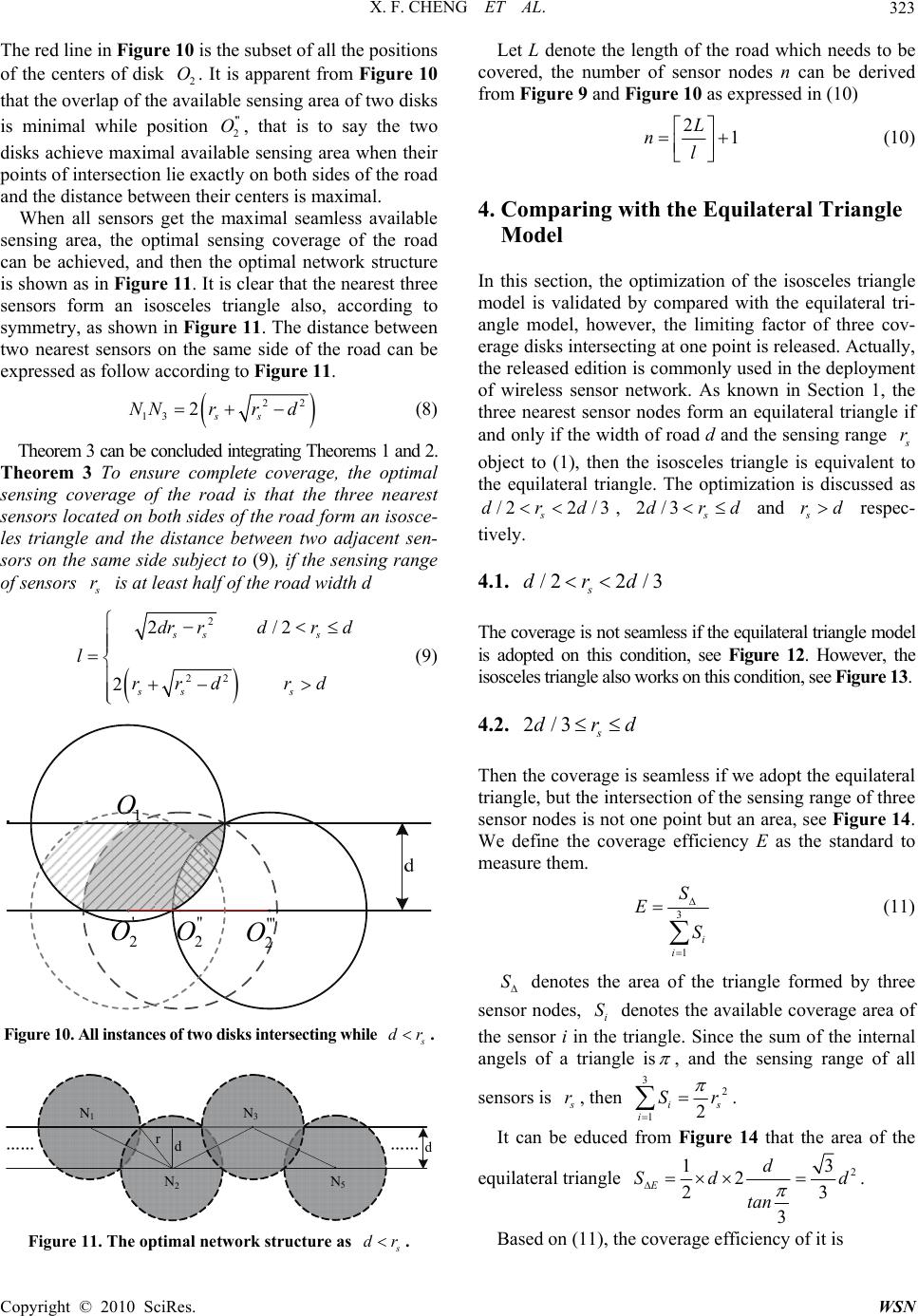 X. F. CHENG ET AL.323 The red line in Figure 10 is the subset of all the positions of the centers of disk . It is apparent from Figure 10 that the overlap of the available sensing area of two disks is minimal while position , that is to say the two disks achieve maximal available sensing area when their points of intersection lie exactly on both sides of the road and the distance between their centers is maximal. 2 O ''' 2 O When all sensors get the maximal seamless available sensing area, the optimal sensing coverage of the road can be achieved, and then the optimal network structure is shown as in Figure 11. It is clear that the nearest three sensors form an isosceles triangle also, according to symmetry, as shown in Figure 11. The distance between two nearest sensors on the same side of the road can be expressed as follow according to Figure 11. 22 13 2ss NNrr d (8) Theorem 3 can be concluded integrating Theorems 1 and 2. Theorem 3 To ensure complete coverage, the optimal sensing coverage of the road is that the three nearest sensors located on both sides of the road form an isosce- les triangle and the distance between two adjacent sen- sors on the same side subject to (9), if the sensing range of sensors s r is at least half of the road width d 2 22 2/2 2 ss s ss s dr rdrd l rrdrd (9) ' 2 O '' 2 O ''' 2 O 1 O Figure 10. All instances of two disks intersecting while s dr . N1 N2N5 …… …… rd d N3 Figure 11. The optimal network structure as s dr . Let L denote the length of the road which needs to be covered, the number of sensor nodes n can be derived from Figure 9 and Figure 10 as expressed in (10) 21 L nl (10) 4. Comparing with the Equilateral Triangle Model e the isosceles triangle model i In this section, thoptimization of s validated by compared with the equilateral tri- ngle model, however, the limiting factor of three cov- disks intersecting at one point is released. Actually, eased edition is commonly used in the deployment a erage e relth of wireless sensor network. As known in Section 1, the three nearest sensor nodes form an equilateral triangle if and only if the width of road d and the sensing range s r bject to (1), then the isosceles triangle is equivalent to o the eqle /2d uilateral triang. The optimization is discussed as 2 /3 s rd , d2/dr and respe s rdc-3s tively. 4.1. /22 /3 s drd The coverage is not seamless if the equilateral triangle model is adopted on this condition, see Figure 12. However, the isosceles triangle also works on t 4.2. d his condition, see Figure 13. 2/3 s dr Then the coverage is seamless if we adopt the equilateral triangle, but the intersection of the sensing range of three sensor nodes is not one point but an area, see Figure 14. We define the coverage efficiency E as the standard to measure them. 3 S E 1 i i S (11) S n e se angels denotes the area of the triangle formed by three se area of thnsor i in m of the internal of a t sor nodes, i S denotes the available coverage the ri triangle. Since the su angle is , and the sensi range of all is ng 3 2 sensors s r, then 12 is i Sr . It can bea of the eq ilateral triangle educed from Figure 14 that the are u2 13 2 2 E tan 3 3 Sd d . Based on (11)e efficiency of it is d , the coverag Copyright © 2010 SciRes. WSN  X. F. CHENG ET AL. 324 Figure 12. /22 /3 s drd . Fsosceles triangle model. igure 13. The i Figure 14. d2/3 s dr. 2 23d 2 3 E s Er (12) rom Figure 13 that the area of the isosceles And it can be educed f triangle 2 2 122 2 Isss Sdrdrddr Since d 2/3 s dr, then the coverage efficiency of the isosceles triangle 2 2 22 2323 3 2 2 2 2 s I E s s d d dd d EE r rr s dd r d That is to say the coverage efficiency of the isosceles triangle model is larger than the equilateral triangle’s. E E and I E can be regarded as functions of s r, then we can validate our conclusion intuitively from the fig- ures of them with the help of MATLAB. As shown in Fiure 15, let the road width d equals 5 m, 15 m and 30 m, and d g 2/3 s dr at, . It can be concluded form Fig- ure 15 th E E equals I E only when , and 2/3 s rd E E is larger than I E in other times. 4.3. As shown in Figure 11, the available coverage area of three nodes in the isosceles triangle formed by them- selves is equal to the coverage area of a sole node on the road surface, and can be expressed as follow s rd 3 22 22 12 iss s is r arccos d Sr r drd The area of the isosceles triangle 22 ( Iss drrd )S Then the efficiency is 22 22 22 () arccos 2 ss I ss s s drr d E d rr drd r (13) As to the equilateral triangle, its coverage efficiency is 1/3 constantly while 23/3 s rd, as shown in Figure 16. When 23 /3 s dr d , the available coverage area of a sole node in the equilateral triangle is the shadow in Figure 17, then 3 22 22 1 3arccos 6 isss is Sr r drd r d Figure 15. Comparing of model coverage efficiency while 2/3s drd . Copyright © 2010 SciRes. WSN  X. F. CHENG ET AL.325 Figure 16. The equilateral triangle model while=2 3 /3 s rd . Figure 17. The equilateral triangle model while << s dr 23/3d. =22 22 3arccos 3 2ss s s d rr drd r And the efficiency is 2 3 3 E d E 22 22 3arccos 3 2ss s s rr drd r To compare them with each other, we also regard them d (14) as functions of s r, and plot them with the help of MAT- LAB. As show Figure 18, let the road width d equals 5m, 15m and n in 30m, and 3 s dr d. It can be concluded that I E is larger than E E, and I E approximates to 1 as s r increases, while E E approximates to 1/3. 5. Simulation Results According to (9) and (10), it is clear that if the road width d, sensor sensing range s r and the road length L are given, then the number of sensor nodes required to cover the road optimally can be calculated in determi- nately deployment instance. In this section, we carry out some simulated experiments based on our conclusions with the help of MATLAB and C++, while d, L and s r 0). are varying. The calculating of n is based on (9) and (1 5.1. The Variance of n While One of d, L and s r m Changes Figure 19 shows the variance of n while L increases fro 100m to 300m, in which d and s r is given. Accordi (10), the two of them is linear, and the figure confirms The slope of the line is , it is determined by (9). Figure 20 shows the change of n while the sens range of the sensor nodes increasing, in which d and given. It can be made out from the figure that n is d ng to that. ing L is e /2l - creasing as s r increasing, and n approximates to 0 when s r is mucher than d. Figure 21 shows the variance of n with d. We clearly see that n goes to infinite when d approximates double of larg can to s r. According to (9) and (10), n is a subsec- tion function and the inflexion comes while d = r, as th figure reveals. 5.2. The Variance of n as Any Two of d, L e and s r Change Figure 22 demonstrates the graph of n as L and in which d = 20m. We can see that n is increasinwh s r g vary, ile s r decreasing and L increasing, and n approxim infinite when ates to s r approximates to 10m that is half of t road width. that n approximates to he 0 Figure 23 shows the graph of n varies with d ands r, while L=300m. It is clearly Figure 18. Comparing of model coverage efficiency while 3 s drd . Copyright © 2010 SciRes. WSN 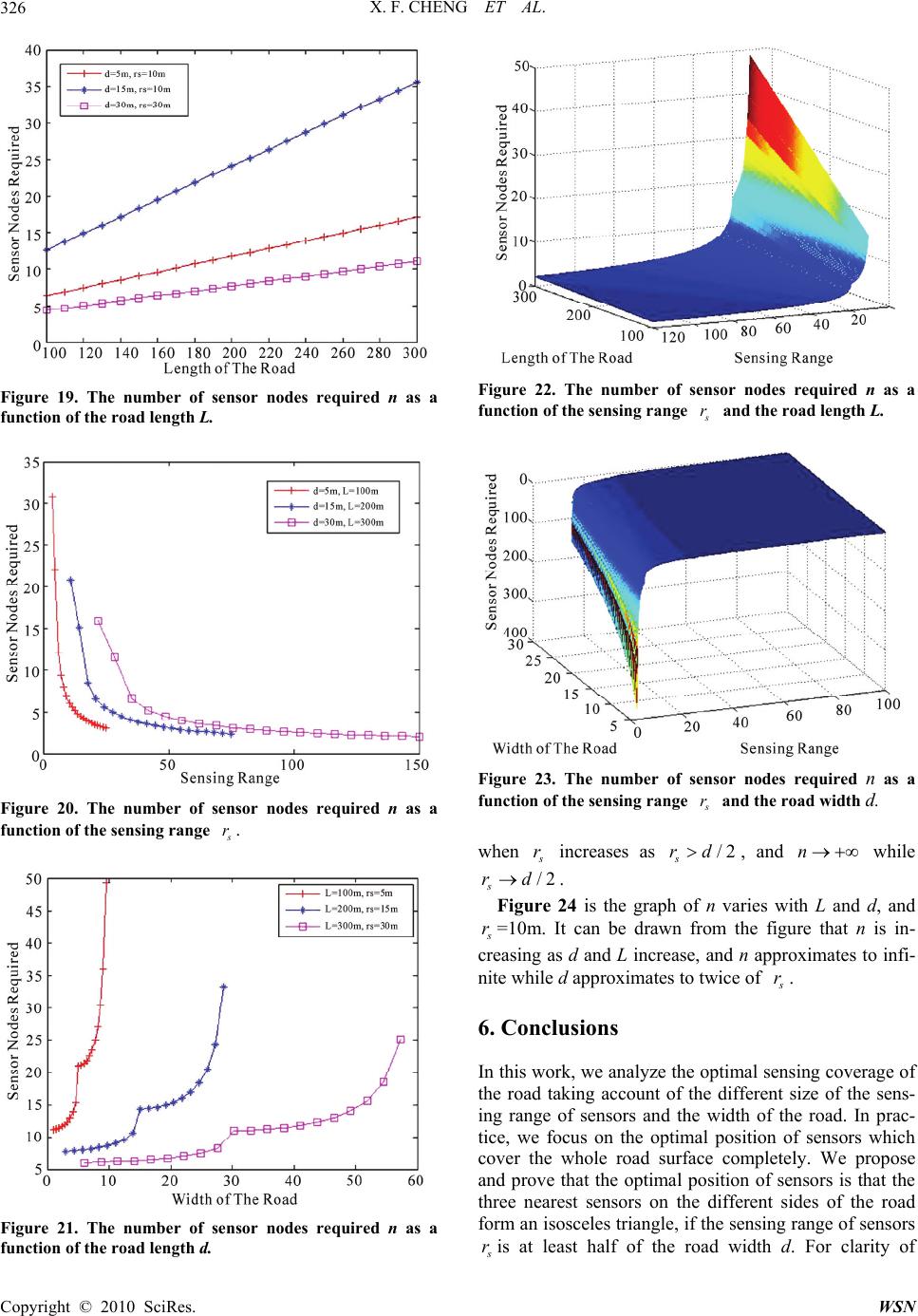 X. F. CHENG ET AL. 326 Figure 19. The number of sensor nodes required n as a function of the road length L. Figure 20. The number of ssor nodes required n asen a nction of the sensing range fu s r. Figure 22. The number of sensor nodes required n as a function of the sensing range s r and the road length L. Figure 23. The number of sensor nodes required n as a function of the sensing range and the road width d. s r Figure 21. The number of sensor nodes required n as a function of the road length d. when s r increases as /2 s rd, and n while /2 s rd. Figure 24 is the graph of n varies with L and d, and s r=10m. It can be drawn from the figure that n is in- creasing as d and L increase, and n approximates to infi- nite while d approximates to twice of s r. 6. Conclusions In this work, we analyze th the road taking account of e optimal sensing coverage of the different size of the sens- es of the road le, if the sensing range of sensors ing range of sensors and the width of the road. In prac- tice, we focus on the optimal position of sensors which cover the whole road surface completely. We propose and prove that the optimal position of sensors is that the three nearest sensors on the different sid form an isosceles triang s ris at least half of the road width d. For clarity of Copyright © 2010 SciRes. WSN 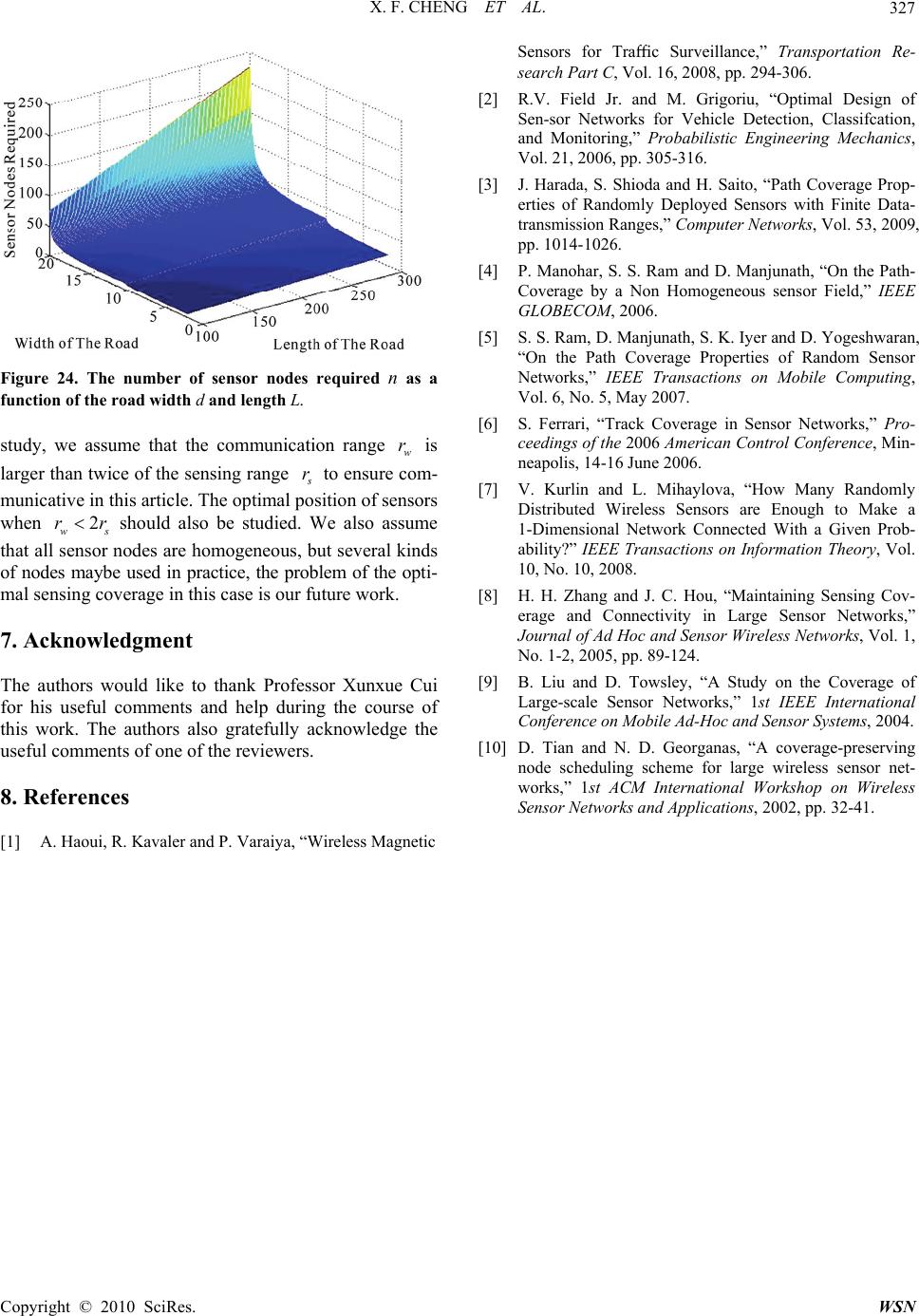 X. F. CHENG ET AL. Copyright © 2010 SciRes. WSN 327 Figure 24. The number of sensor nodes required n as a function of the road width d and length L. study, we assume that the communication range is w r larger than twice of the sensing range s r to ensure com- municative in this article. The optimal position of sensors n 2rrshould also bewhe th ws studieWe also ase at all sensor nodes are homogeneous, but several kinds f nodes maybe used in practice, the problem of the opti- al sensing coverage in this case is our future work. . Acknowledgment e authors would like to thank Professor Xunxue Cui or his useful comments and help during the course of is work. The authors also gratefully acknowledge the useful comments of one of the reviewers. 8. References [1] A. Haoui, R. Kavaler and P. Varaiya, “Wireless Magnetic c Engineering Mechanics, ting, Vol. 6, No. 5, May 2007. [6] S. Ferrari, “Track Coverage in Sensor Networks,” Pro- ceedings of the 2006 American Control Conference, Min- neapolis, 14-16 June 2006. [7] V. Kurlin and L. Mihaylova, “How Many Randomly Distributed Wireless Sensors are Enough to Make a 1-Dimensional Network Connected With a Given Prob- ability?” IEEE Transactions on Information Theory, Vol. 10, No. 10, 2008. [8] H. H. Zhang and J. C. Hou, “Maintaining Sensing Cov- erage and Connectivity in Large Sensor Networks,” Journal of Ad Hoc and Sensor Wireless Networks, Vol. 1, No. 1-2, 2005, pp. 89-124. [9] B. Liu and D. Towsley, “A Study on the Coverage of Large-scale Sensor Networks,” 1st IEEE International Conference on Mobile Ad-Hoc and Sensor Systems, 2004. [10] D. Tian and N. D. Georganas, “A coverage-preserving node scheduling scheme for large wireless sensor net- works,” 1st ACM International Workshop on Wireless Sensor Networks and Applications, 2002, pp. 32-41. d. sum Sensors for Traffic Surveillance,” Transportation Re- search Part C, Vol. 16, 2008, pp. 294-306. [2] R.V. Field Jr. and M. Grigoriu, “Optimal Design of Sen-sor Networks for Vehicle Detection, Classifcation, and Monitoring,” Probabilisti Vol. 21, 2006, pp. 305-316. [3] J. Harada, S. Shioda and H. Saito, “Path Coverage Prop- erties of Randomly Deployed Sensors with Finite Data- transmission Ranges,” Computer Networks, Vol. 53, 2009, pp. 1014-1026. [4] P. Manohar, S. S. Ram and D. Manjunath, “On the Path- Coverage by a Non Homogeneous sensor Field,” IEEE GLOBECOM, 2006. [5] S. S. Ram, D. Manjunath, S. K. Iyer and D. Yogeshwaran, “On the Path Coverage Properties of Random Sensor Networks,” IEEE Transactions on Mobile Compu o m 7 Th f th |

